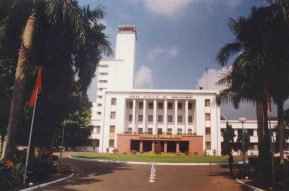From time immemorial, India has been a centre for learning. Thousands of years ago, great scholars used to teach through the scriptures. A variety of subjects such as philosophy, religion, medicine, literature, drama and arts, astrology, mathematics and sociology were taught and masterpieces on these subjects were written. Under the Buddhist influence, education was available to virtually everyone who wanted it and some world famous institutions arose out of the monasteries, such as Nalanda, Vikramshila and Takshashila. Nalanda, which flourished from the fifth to 13th century AD, was especially noteworthy. It had at one time about 10,000 resident students and teachers on its roll, including Chinese, Sri Lankan, Korean and other international scholars.
During the 11th century, the Muslims established elementary and secondary schools, "Madrasas" or colleges, and even universities at cities like Delhi, Lucknow and Allahabad, mostly using Arabic as the medium of instruction. During the medieval period, there was excellent interaction between Indian and Islamic traditions in all fields of knowledge like theology, religion, philosophy, fine arts, painting, architecture, mathematics, medicine and astronomy.
With the arrival of the British, English education came into being with the help of the European missionaries. In 1817, Hindu College was established in Kolkata. The Elphinstone Institution was set up in 1834 in Mumbai. In 1857 three universities were set up at Kolkata, Chennai and Mumbai. Since then, Western education has made steady advances in the country. With 226 universities and thousands of colleges affiliated to them, 428 engineering colleges and technological institutes, more than a 100 medical colleges, scores of agricultural institutes and many other specialised centres of learning and research in every subject and discipline, India can claim its position as one of the leading countries providing quality higher education to its people as well as to students and scholars from countries all over the world.
Today Indian universities and institutes of higher education and research today have made a significant contribution to transmission of knowledge and enquiry into frontiers of science and technology. In the field of traditional subjects such as arts and humanities as well as in pure sciences, applied physics and chemistry, mathematics and in areas of technology, the universities and higher institutes have been playing a leading role in transforming the country into a modern industrialised, technologically advanced state. The ushering of the Green Revolution and the tremendous progress in dairy development have made India a major food-producing country on one hand; on the other hand, its development of space technology, production and launching of indigenous satellites, development of peaceful nuclear energy have brought it into the forefront of technologically advanced nations to which a large number of developing countries looks for training and guidance.
Indian universities and institutes of higher learning have been playing their role to promote the needs and aspirations of higher education and research to Indian students and scholars. These centres have been extending their cooperation and friendship towards students of other developing countries also, where facilities for higher studies and research are not adequate. In addition, a number of overseas students are also drawn to Indian educational institutions providing high-quality education at very competitive prices.

(Indian Institute of Technology, IIT-Kharagpur)
Institutes of Higher Education
For further information on Studying in India, Refer -
International Schools in India









